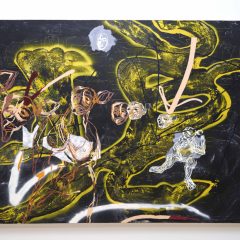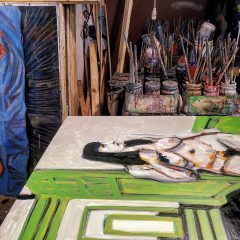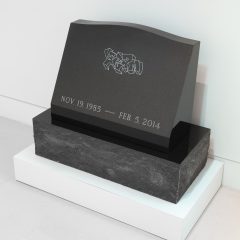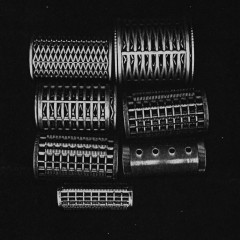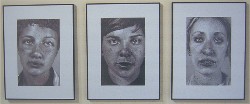
three untitled faces invented in cyberspace by Nils Orth
This year’s Arcadia Works on Paper biennial is one great show, and you need to commit a date for it on your calendar or it may blow right by you. It’s only up through April 25.
For starters it’s the anti-matter version of Wyeth. To put it another way, the show is a breath of fresh air in the claustrophobic parochialism that sometimes infects Philadelphia. It’s lively. It’s right up to date on what’s happening now in the art world–and by world, I mean the real world, the whole wide world, and the brave new digital world.
For one thing, paper, as we all know, has broken out of the classroom and the notebook, taken on a gravitas and materiality that previously was reserved for canvas and bronze.
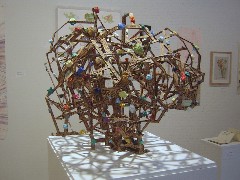
Springsprung, by Thomas Vance, is an atomic head of cardboard, scuptamold, ink and acrylic
I suppose the immateriality of bits and bytes is what has made paper suddenly look like something that lasts. I mean, how many computer files have all of us lost thanks to computer crashes, a touch of the wrong button or a change in technology? I have art on old zip drives with no way to access them. I have words lost to xywrite obsolescence. And I change my email client on a regular basis without being able to haul along the old emails to the new program.
If you’ve been seeing much of the art that we’ve been seeing around Philadelphia in the past couple of years, you’ll recognize a lot of the names in this exhibit, which includes 48 works by 40 area artists.
Here’s who:
James Abbott
Stefan Abrams
Susan Abrams (no relation so far as we can determine)
Phillip Adams
Joseph Borelli
Natasha Bowdoin
Astrid Bowlby
Matt Broach
Arden Bendler Browning
Robert Chaney
Adam Crawford
Christopher Davis
Sarah Daub
Kip Deeds
Mary Deevy
Jessica Doyle
Anda Dubinskis
Robert Gallardo
Ditta Baron Hoeber
M Ho
James Johnson
Gabriel Martinez
Michelle Oosterbaan
Nils Orth
Norman Paris
Jessica Puma
Stuart Rome
Emily Royer
Richard Ryan
Hiro Skaguchi
Judith Schaechter
John Schlesinger
Randall Sellers
Adam Parker Smith (for a grid of drawings by his student!)
Janet Towbin
Ivette Vallejo
Thomas Vance
Brent Wahl
Bryan Warner
Linda Yun
I want to give each and every artist in the show a cosmic hug.
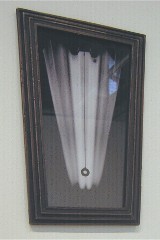
Untitled, an inkjet print and bronze frame from John Schlesinger. Its dimensions are not to be trusted.
Part of what interested me in the exhibit, was the tension between the big lie and the big truth–or how art tells the truth by making up lies. That question of what is to be trusted is most obviously presented in the photo-based work, like John Schlesinger’s untitled inkjet print of a fluorescent light, the crazy angles of the frame reflecting the point of view from which the light was taken and looking a lot like my bad photographs of art in artblog. Even if you know the piece has no right angles, you certainly can’t tell from my photograph just what angles they might be. Roberta’s photograph here spells it out by offering some context.
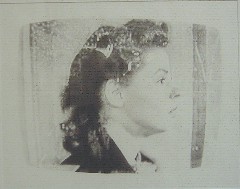
Thinking Ingrid, by Mary Deevy
Across the room, Mary Deevy’s Thinking Ingrid looks photographic but is a graphite drawing of Ingrid Bergman on a television screen, the image falling apart. We don’t know how much is due to celluloid failure, how much to tv failure and how much to tv screen reflections. But we do know that Bergman and all that she represents, including standards of beauty, are degrading and being called into question. And that’s the truth.
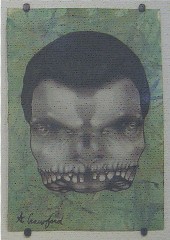
Levitating Wide Mouth, by Adam Crawford
Near Schlesinger’s photo, Adam Crawford’s Levitating Wide Mouth is so weird you know it’s a lie in spite of its photographic qualities.
Computer-manipulated photos by Nils Orth (see photo at the top of the post) generate their own versions of the truth. Orth’s untitled faux-toshop portraits reek of merciless mug shots, cosmetic surgery, and gender confusion. Their creepiness is captivating as they teeter on the edge of almost believable.
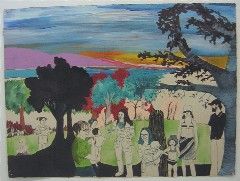
Untitled, by Jessica Doyle, made of graphite, ink and acrylic on paper
The drawings here range from representation to any number of something elses. I loved how Jessica Doyle’s untitled moms on a picnic with kids in tow, all looked distracted by the kids and absorbed with keeping things in control–a sort of anti-matter take on the old languid leisure-class portraits of Alex Katz or Fairfield Porter. Speaking of anti-matter, the people are merely black outlines, while the landscape behind them is a Fauve arcadia.
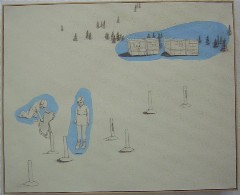
Untitled, by Emily Royer
The only color in Emily Royer’s drawing of two kids playing near two boxy houses near the woods are sky-blue puddles of gouache surrounding the kids and the houses, auras of energy or memory that make the pencil marks immaterial and the space, well, spacy. What are those bollards sticking up near them? Landfill gas pipes? Or maybe those are troll chimneys from underground dwellings. The possibilities are numerous and creepy.

Spruce Street, by Richard Ryan, inkjet print
And speaking of matter and anti-matter, a trio having intense conversations with one another are Richard Ryan, Thomas Vance and Linda Yun.
Ryan’s inkjet print, Spruce Street, turns the city into a rollercoaster pair of love knots balancing light and dark, day and night, real and romanticized, as the city barely pauses for a fashion photograph in front of a white backdrop.
Ryan’s cool and elegant portrait, that also brings to mind textbook images of atoms with their whirling parts, is right near Thomas Vance’s Springsprung (second photo from the top of the post), also a portrait of an atom–or of a head on lsd–merging high-tech thoughts with humble materials, elegance with lumpiness.
In utter contrast but with some similar thoughts about the ordinary and the extraordinary, Linda Yun’s stacks of ordinary computer paper become an extension of the 8 1/2 x 11-inch pedestals on which they rest in recognition of the beauty in the objects we take forgranted. The work brings aesthetic seriousness to Duchampian readymades. A couple of inches of blue paper in one stack magically transforms the everyday materials into a minimalist work, and the blush of makeup dusted on the other stack magically transorms it into a color-field totem. These concordances are typical of the exhibit, which is mounted with intelligence and wit.
Most of the work in this show was made in 2005 and 2006 with only five exceptions–the drawings from Judith Schaechter (can you believe she has never before been in an Arcadia Works on Paper exhibit? the times must have finally caught up with her), a series of fierce self-portraits by Ditta Baron Hoeber and gelatin silver prints of landscapes from James Abbott and Stuart Rome, excellent all.
I wanted to write about every work in this show, but I’ll restrain myself. Our Flickr sites have more photographs. Here’s my set, and here’s Roberta’s set. Check them out.
By the way, the works were selected from 883 submissions by Cornelia Butler, chief curator, department of drawings at MoMA. Butler will be speaking April 18 at 6:30 in Stiteler Auditorium in Murphy Hall (it’s up the hill from the gallery), and the reception will follow immediately after.


